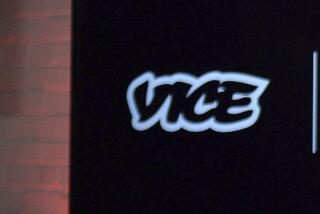Video-centric news outlet Mic lays off most of its staff
- Share via
The phrase “pivot to video” haunted digital journalists in 2016 and 2017, as publication after publication announced that they were laying off writers to redirect their resources into making videos. Mic, a digital publication focusing on a millennial audience, was one of the outlets that adopted that strategy. In 2017 it laid off 25 people, mostly from news and editorial, to become “the leader in visual journalism,” founder Chris Altchek wrote at the time.
The pivot, it seems, did not save them. On Thursday, Mic laid off most of its staff amid reports that it is preparing to sell itself to Bustle Digital Group. But the pivot was just a symptom of a bigger problem: how to make a digital journalism venture profitable. Mic’s other attempts to turn $60 million in venture funding into a sustainable business model also failed. Pivot or not, this ending was coming.
The layoffs, first reported by Recode, were announced during a Thursday morning staff meeting with Altchek. According to one laid-off staffer, the meeting was brief and expected: Earlier media reports revealed the dire situation. The layoffs included Mic’s entire editorial team, video and written, the staffer said. The company, founded in 2011 as PolicyMic and rebranded to simply Mic in 2014, employed more than 100 people as of September.
Mic’s traffic dropped precipitously over the last year. In April, Digiday reported that Mic’s website was down to 5 million monthly unique visitors. Just a year earlier that number was 17 million. None of Mic’s other sources of audience — particularly Facebook — were offsetting that steep drop.
Mic Publisher Cory Haik announced in a note to staff that she was resigning from the company. “Our business models are unsettled, and the macro forces at play are all going through their own states of unrest.... I am proud to have been a part of an org that earnestly tried to solve some of these confounding issues. And I hope you all take some comfort in knowing that your work will transcend this moment.”
The Wall Street Journal reported in September that Mic was considering an acquisition offer from another media company, as executives believed the company would have to either sell or cut costs within a year. Earlier this week, Recode reported that Mic’s show on Facebook Watch had been canceled, limiting the company’s options even further.
Mic’s former executive news director, Kerry Lauerman — who also resigned — said in an interview that he was proud of the work Mic’s team achieved.
“Clearly, there were some risks taken that didn’t pay off. Today, the staff is really sad, but we’re enormously proud of the work we’ve done through it all,” Lauerman said. He singled out the work of the Facebook Watch video team, noting that it had recently produced stories embedded in the large migrant caravan in Mexico. He also highlighted the work of Serena Daniari, a trans reporter who produced a series documenting what it’s like to be a trans person in a public space.
Lauerman and Haik are both former employees of the Washington Post.
Mic was one of many publications that pinned its hopes for growth on traffic that came via Facebook as it pushed to meet its investors’ expectations. “Most newsrooms have come to regret making hiring and investment decisions based on the whims of a company that really doesn’t care much about journalism,” said Bill Grueskin, a professor at Columbia Journalism School. Facebook was often “opaque” toward its media partners. And in the case of average watch time on its videos, Facebook overestimated that key metric for two years.
“Mic wouldn’t be the first site to have funders that are driving unrealistic growth targets, forcing the company into a relationship with such a dubious and fickle company,” Grueskin said.
Thursday was the latest version of a bleak ritual that has become standard when digital media companies purge their staffs, a ritual that has become more frequent since Facebook’s announcement in January that its users would see fewer posts from publishers — as opposed to friends — in their feeds. The Outline laid off six staffers over the summer, months after a $5-million funding round. LittleThings shut down. In February, Vox Media laid off about 50 employees.
With each layoff, the newly unemployed staff writers and video producers flood Twitter, suddenly among the ranks of digital media’s growing pool of freelancers and job hunters. And with each layoff, there seem to be fewer digital outlets that could hire them.
The lessons that some publications, like Mic, learned the hard way are starting to sink in at others, according to Grueskin. As digital advertising increasingly becomes a space dominated by major tech companies such as Facebook and Google, some publishers are starting to seek out other sources of revenue including subscriptions, donations, events and apps.
“Once you move your media firm into that arena, your dependence on other platforms drops off, and you can treat Facebook with the same disdain that they’ve treated newsrooms for years,” Grueskin said.
Ohlheiser writes for the Washington Post.
More to Read
Inside the business of entertainment
The Wide Shot brings you news, analysis and insights on everything from streaming wars to production — and what it all means for the future.
You may occasionally receive promotional content from the Los Angeles Times.










